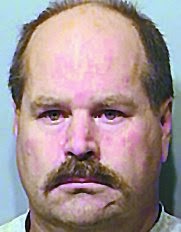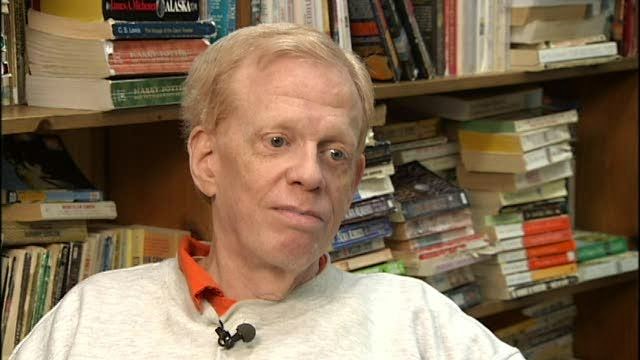 |
| Edgar Steele (center), Cyndi (front, left), and their family. |
Death threats received by the family of Edgar and Cyndi
Steele during the
2000 civil trial of Aryan Nation leader Richard Butler
“We are not going to be providing you with any protection,”
the federal marshal told Cyndi Steele after she and her son had been ushered
into a room in the Kootenai County Courthouse in Coeur d’Alene, Idaho. This was
not what Cyndi expected to be told. After all, she recently recalled in a
telephone interview, “I had just learned that I had been driving around with a
bomb on my car.”
That bomb, which had been discovered during an oil change,
had been attached to her car by a local handyman named Larry Fairfax, whom
Cyndi and her husband Edgar had employed to do some work on their ranch in
Sagle, Idaho.
Fairfax, the man who admitted
to planting that bomb, served
less than a year in federal prison for “possession of an unregistered firearm”
and “manufacturing a firearm.” He
was granted early release to a halfway house in Coeur d’Alene, a facility “that
was nicer than most hotels I’ve visited,” Cyndi wryly observes. He is now
living less than two miles away from his victim, who was not granted a
restraining order “because I was not in a domestic relationship with him,” she
reports.
Edgar Steele, who was convicted – largely on the strength of
Fairfax’s self-serving and self-contradictory
testimony – of plotting to murder Cyndi, died
last Thursday (September 4) in the federal prison in Victorville, California,
where he was serving a 60-year sentence.
The jury in the federal trial, which was held before Judge
Lynn Winmill in Boise, consisted of eleven women and one man. The prosecution
used voir dire to exclude from the panel any potential juror with specialized
knowledge of acoustics or explosives, and to weed out anybody who evinced
hostility or even skepticism toward the federal government.
It is not an exaggeration to say that the jury was specially
crafted to be receptive to the prosecution’s narrative, in which Edgar, a man
in his 60s, supposedly hired someone to kill his middle-aged wife in order to
allow him to take up with Tatyana Loginova, a nubile Ukrainian woman with whom
he had been conversing online.
Cyndi
insists that those online chats were part of Edgar’s research into what he
described as an extortion scam being run out of the former Soviet Union.
However improbable that story might appear, it is more plausible than the idea
that an embattled political dissident, facing constant scrutiny by the Feds death
threats from politically connected enemies, would conspire to murder the wife
who had nursed him through several cardiac-related health crises.
That matter was rendered moot by the fact that the alleged
victim didn’t believe for a peeled fraction of a split second that her husband
had arranged to kill her, and never filed charges against him. In anticipation
of Cyndi’s refusal to collaborate, FBI agent Michael Sotka, who orchestrated
the operation, paid Fairfax $500 and sent him to Oregon to make a phone call to
Steele’s home, thereby forging the “interstate nexus” used to justify prosecuting
him in federal court.
As both Cyndi and Edgar told the story, when Fairfax came to
work for them he was upside-down on his mortgage and facing foreclosure. His
prospects brightened considerably after he was able to make a substantial payment
to the mortgage holder by cashing in a considerable amount of silver coins he
had acquired from the Steeles.
Cyndi and Edgar insisted that Fairfax, who had the run of
their property, stole about $45,000 in silver from them. Fairfax claimed that
he had been given the silver by Edgar as payment in a murder-for-hire plot
targeting his wife and mother-in-law. Supposedly stricken by remorse – or,
perhaps, to cover up his theft -- Fairfax went to the FBI, who fitted him with
a digital recorder and sent him back to the Steele family’s ranch to discuss
the alleged plot.
No original copy of exists of the digital recording from
that June 10, 2010 conversation. Special Agent Michael Sotka violated Bureau
procedures by purging it from his recorder after using a computer to upload the
digital file to the FBI lab in Quantico, Virginia. He did this without a second
agent being present, as regulations specify.
Sotka and an Idaho State Trooper named Jess Spike visited
Edgar Steele the following day – June 11, 2010 – to tell him that his wife and
mother-in-law had been killed. They later admitted that this was a “ruse”
intended to prompt Steele into saying or doing something that would incriminate
himself in the crime.
Steele, a self-described white nationalist, was an attorney
involved in civil litigation on behalf of unsavory and disreputable clients,
such as Richard Butler of the Aryan Nation white separatist group. (For reasons
made obvious by the photograph accompanying this essay, I have no affinity for
that ideology.) Steele had represented Butler ten years earlier after a lawsuit
had been filed against his neo-Nazi clique by the equally reprehensible
Southern Poverty Law Center. Since that time, he and his family had received
numerous death threats, some of which alluded to possible lethal retaliation by
the FBI.
Understandably, his first reaction to the grim news on June 11, 2010
was to believe that his family was under siege, and that the federal agent in
his living room might well be working in concert with his enemies. Although his wife and mother-in-law were unharmed any
suspicions Steele harbored about the role played by the Feds were entirely
vindicated. Despite the fact that Edgar did nothing to indicate guilty
foreknowledge of the supposed bombing plot, Sotka arrested him anyway.
At the time, Cyndi had traveled from Sagle to Oregon City,
Oregon to visit her mother. Nobody told her about the pipe bomb that had been
affixed to the undercarriage of her SUV, or a similar device that had been
attached to Edgar’s Cadillac. She discovered the bomb – which, it was
later disclosed, was essentially a stage prop incapable of being detonated –
shortly before going to the courthouse to attend Edgar’s preliminary hearing.
“They played the recording [of the supposed conversation
with Fairfax] at the time, and my first reaction was that it didn’t sound
anything like Ed,” Cyndi told me. “They played it to me on a couple of other
occasions, and every time it changed. In the first version, it was possible at
one point to hear the word `bomb,’ but when I heard it again that had been
changed to `car bomb.’”
The recordings were analyzed by forensic scientist Dr.
George Papcun, who has served as an expert witness and advisor on behalf of
numerous law enforcement agencies, including the Department of Homeland
Security. Dr. Papcun, who is among the most qualified and respected specialists
in his field, detected roughly 300 “transients” and other anomalies in the
recording, leading him to conclude that there was “a reasonable degree of
scientific probability that they [the recordings] do not represent a true and
valid representation of reality and they are unreliable.”
During Steele’s May 2011 trial, the prosecution attempted to
exclude both Dr. Papcun’s report and his testimony. Judge Winmill initially
ruled that Papcun, who was on vacation in Bora Bora, would be allowed to offer
testimony via interactive video conference.
The prosecution objected, claiming that this arrangement
would not permit them to “confront” the witness – a right guaranteed to the
defense, not the prosecution, by the Sixth Amendment. On May 3, Winmill
reversed himself, ruling that Papcun would be permitted to testify only if he
were physically present no later than 8:30 a.m. the following morning – which
was a physical impossibility. Both Papcun and the defense were willing to pay
the expense necessary for the witness to appear on May 5, but Winmill insisted
that he simply couldn’t spare another day in order to allow the defense to
present its case.
By way of contrast, Winmill permitted
the prosecution to present a video-recorded deposition by Tatyana Loginova,
the young Ukrainian woman and supposed object of Steele’s extra-marital
affecton, who was deposed at a US consulate in Kiev with the help of a Russian
language translator.
The evidence against Steele (as
I have documented in ample detail elsewhere) consisted of a doctored audio
recording, the testimony of an
admitted liar and attempted bomber, and a self-serving video deposition by
a foreign national from a dubious background who was shielded from effective
cross-examination. During jury selection, Assistant US Attorney Traci Whelan
subjected potential jurors to invasive scrutiny regarding potential “hidden
biases” against “the United States Government.”
“The judge actually instructed the defense on several
occasions not to present anything [or] ask any questions, or make any
objections that would make the government look bad,” observed attorney Wesley
Hoyt, who represented Edgar in his appeal. “We used to have something called
the presumption of innocence.... Anybody who was accused of a crime was
presumed innocent … the government had to put on enough evidence to prove
beyond a reasonable doubt that the person was guilty. Now there’s a presumption
of governmental regularity and correctness. What that means is that the court
presumes that everything that the government does is in the regular course of
business, and that it’s normal, and it’s OK, and it’s correct.”
Whatever the merits of the federal case against Edgar
Steele, the prosecution did not convince the most important jury – the supposed
victim.
“From the very beginning they treated me with hostility,”
Cyndi related to me. “They did nothing to warn me about having a bomb on my
vehicle, then after it was discovered I was explicitly told that I could expect
no protection.”
Larry Fairfax, the man who admitted to placing that bomb on
Cyndi’s SUV, was ordered to pay her the sum of $900 in compensation. Her husband,
who had no hands-on role in the matter, was sent to prison for life. The only “protection”
Cyndi received was from a man she was convinced had done him no harm.
“The last time I saw Ed was in November 2011, while he was
in the county jail waiting to be transported to prison,” Cyndi recalls. “Our
kids were able to visit him in California, but I wasn’t permitted to. We did
speak on the phone often, and I was concerned about the fact that he was
suffering from severe medical neglect.”
During the months leading up to his arrest, Edgar had
experienced severe heart problems and suffered an aneurysm that was nearly
fatal. In prison he contracted pneumonia that was left untreated for several
weeks. When he tardily received treatment, he was diagnosed with a heart
murmur.
About three weeks before he died, Edgar stopped calling,
which left Cyndi frantic.
“We were talking about twenty times a month, so the absence
of phone calls from Ed was alarming,” she told me. “I couldn’t find out how he
was doing. Nobody at the prison would tell me anything. On the day before he
died I got a forwarded email from an inmate who was watching Ed’s back that
made me very concerned about him. He had been taken from Victorville to testify
at a trial in West Virginia, and when he got back Ed was unrecognizable to him.”
“I got back on the writ 6 days ago, and the next day,
Friday, Edgar went to the hospital,” wrote the
inmate, Jake Laskey, on September 3. “He got back from hospital yesterday
and didn’t know who he was nor what unit he lives in, and … he’s back in a
wheelchair. I saw Edgar today at lunch. He was being pushed back to Medical and
barely recognized me, He was half naked in his wheelchair, skinny as a
skeleton, unkempt, and his mind was gone.”
Cyndi hastily made arrangements to fly down to California to
meet her children and visit with her husband on September 5. Those plans
dissolved after Cyndi received a terse and unexpected phone call from a local
mortuary asking what “arrangements” she wanted to make for the disposition of
Edgar’s remains.
“The prison administration never contacted me,” Cyndi told
me, weary bitterness shading her voice. “We hadn’t been told he was sick, let
alone that he was near death. Even now, several days after he passed, the
prison hasn’t given me official notice.”
One need not sympathize with Edgar Steele’s views about race
to appreciate his willingness as an attorney to defend the rights of clients
widely regarded to be despicable. One need not be persuaded of his innocence to
entertain abundant reasonable doubt regarding the federal case against him.
The contrast between the draconian punishment inflicted on Steele, and the solicitude
displayed by the Feds toward the self-confessed “hitman” amply justifies the
belief that Steele was, at best, the victim of selective prosecution – and, at
worst, a political prisoner who was effectively murdered by the Regime through
focused, deliberate neglect.
If Cyndi had been an actual crime victim, she would have
been notified that the man who tried to kill her was dead. But that isn’t the
case: Larry Fairfax, the man who placed the bomb on Cyndi’s SUV lives just down
the street, in the house he paid for with money he claims to have received as
part of the plot to kill her.
Cyndi complains that the Feds lied to her persistently from
the moment her husband was arrested, but they told her one incontestable truth:
They said that she and her family – who had endured death threats for years -- wouldn’t
receive any protection, and made good on that promise.
Dum spiro, pugno!






8 comments:
Reading this post, even while I have told Edgar many years ago that I conscientiously but respectfully disagreed with his views, has left me with the conclusion that there is nobody left of any redeeming value in the federal government and that they should - for the well-being and future continuation of all humanity - be wiped from the face of the earth. The possible exception to that would be the good men & women of our Armed Forces, the grunts who shoulder the heavy burden. Generals are not included in that exemption.
Edgar entered the Kingdom with a
warm welcome...and a "Well done my good and faithful servant," greeting from the King.
He's not in pain or torment & looks like he'll be in good company from here on out...
can't say the same for the supporters and worshippers of state sponsored terrorism
sincerely
Davy
Isn't it strange how troublemakers like Edgar Steele and Irv Rubin, who are unpopular and relatively friendless, seem to die in prison.
These types are used as a scapegoat and stereotype for Judaic criticism. Obviously they are psycho-pathological.
Saw this and thought of Mr. Grigg
http://www.youtube.com/watch?v=JQA5HAiT8rI
I see the comments are in low numbers on this story. Frankly, just because a lawyer represents a client who is labeled a racist doesn't make that lawyer a racist. Many times lawyers get personally involved in cases because of they see a huge injustice and feel its their Constitutional duty to step up. Even if someone is a racist, its not against the law but the law of political correct speech. In this country many people are full on Marxist believing the American way must be destroyed so the communist way can move forward. Thats not against the law but is just fine in the warped world of political correct speech. In that same world of political correct speech. Attacking and slandering Christians is just fine and dandy. Even while ten's of thousands of them are being slaughtered in the Middle East, the media is silent. The politically correct media being noted.
Be more concerned with people's rights being violated because when they came for the unionist I didn't care because I wasn't a unionist. Injustice of any kind against people's rights to live free and not bother any others, is an injustice to all who want to be and remain free.
from donna in north dakota:
Thank you, anonymous at 7:38 AM ~
“Justice will not be served until those who are unaffected are as outraged as those who are.” Benjamin Franklin
Typical of the state there supposed to take care of the people but often than not prefer to take care of themselves and favored cronies.
were better off without it frankly we can't count on them for anything.
Post a Comment